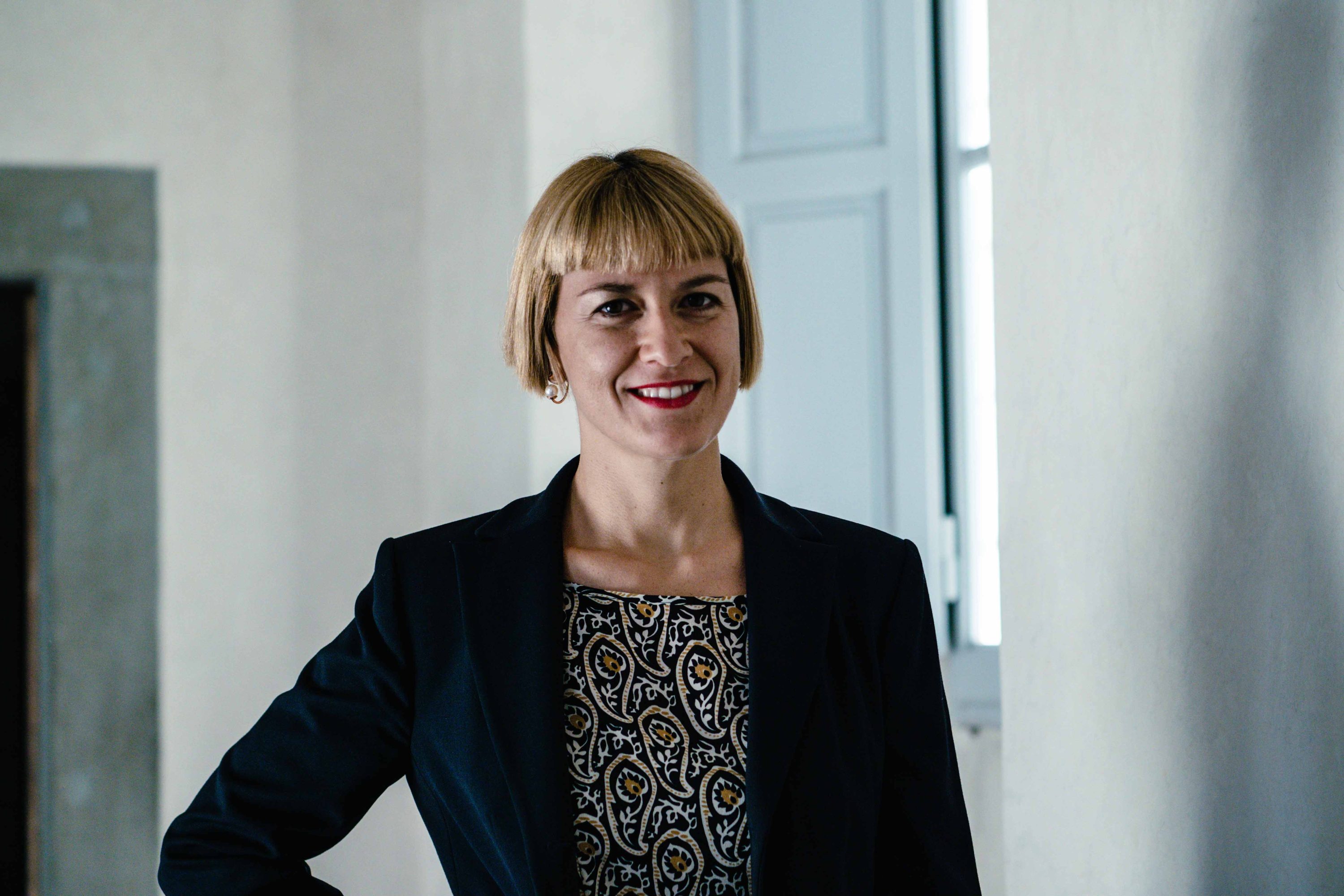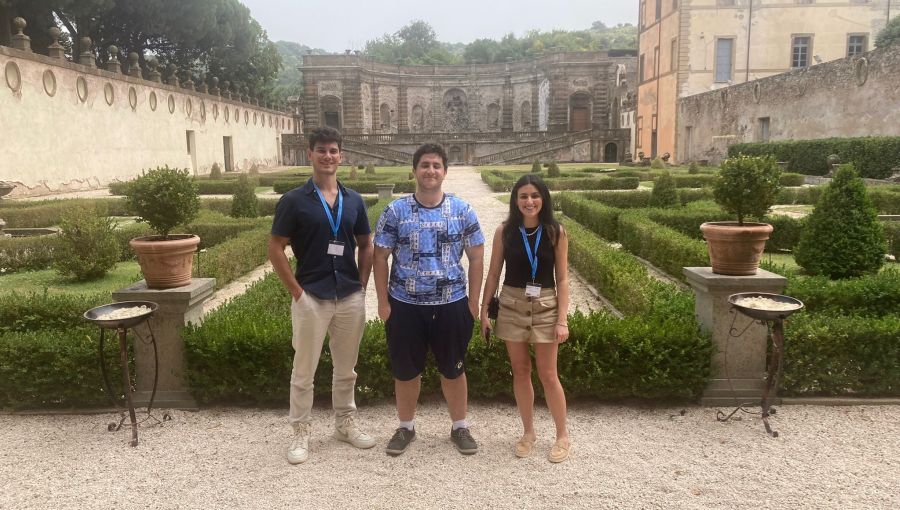Alumna Valeria D’Ambrosio Curates GRASPING THE COSMOS Project
Alumna Valeria D’Ambrosio graduated as Valedictorian in 2009 with a B.A. in Art History and a minor in Italian Studies. She holds an M.Sc. in Modern Art from The University of Edinburgh and a master’s in Arts & Cultural management from IULM University. Valeria is an art historian and contemporary art curator and is currently Research Fellow at the Galileo Galilei Institute for Theoretical Physics in Florence. She is the curator of the GRASPING THE COSMOS project.

Tell us about your background. How did you become passionate about art?
I am the only humanist in a family of scientists. I grew up among doctors, biologists, entomologists, and nutritionists and I originally wanted to become a marine biologist. When I moved to Rome as a teenager, I bumped into the world of the arts, culture, and humanities. Living in Trastevere proved an everyday informal school that unexpectedly introduced me to Blessed Ludovica Albertoni through Gian Lorenzo Bernini’s hands, Saint Cecilia’s sweet teenage body as interpreted by Stefano Maderno, and Sebastiano del Piombo’s version of the Flagellation of Christ. Moreover, at that time, the neighborhood was full of movie theaters that offered all kinds of art-house films, and I remember going up to five times a week. Such a constant, continuative, and varied exposure to artistic languages coming from different eras must have influenced to the point that I drastically shifted my academic direction.
Throughout my academic years, I studied art history, experimental film, and culture management, which soon proved to be the other side of the coin of my passion: Science and Art, two worlds seemingly so distant, became a single lighthouse showing me the road.
Where did your studies take you?
After concluding my studies, I moved to Paris, where I worked as a film curator in an audio-visual archive founded by a creative marine biologist and eclectic artist Jean Painlevé, who created Scientific Cinema, a film genre that combines art, science, and technical experimentation. Thanks to Painlevé, I understood that I could give life to a fruitful and creative dialogue between art and science in order to unify the two most essential aspects of human intellect.
As Research Fellow at the National Institute of Nuclear Physics in Florence, I curate a cultural project in dialogue with physics, astrophysics, the history of science and the varied languages of contemporary art for the valorization of Villa Galileo. This is the 17th-century house where the Italian philosopher, astronomer and mathematician spent the last eleven years of his life under house arrests after being condemned by the Roman Catholic Church.
You are the curator of the GRASPING THE COSMOS project. Tell us more about it.
GRASPING THE COSMOS is an art and science project born from the collaboration between the Museum System of the University of Florence and the Galileo Galilei Institute for Theoretical Physics. Its main purpose is to open Villa Galileo to the public through a cultural program in which science, contemporary art, history of science and the most pressing issues of today’s society dialogue with each other. By adopting a multidisciplinary approach, the project is structured in three phases during which artists and scientists work together for the creation of exhibition projects to ensure continuous and ever-changing cultural contents for Villa Galileo. Il senso delle stelle is the first phase launched at the beginning of 2023, a residency for artists within the Galileo Galilei Institute’s Winter School titled Theoretical Aspects of Astroparticle Physics, Cosmology and Gravitation. This advanced training course, open to young theoretical physicists from all over the world, aims to provide knowledge in the fields of gravitational waves, neutrino physics and astronomy, dark matter and dark energy, galactic and extragalactic cosmic rays.
Through dialogue with the school scientists, I curated the solo show of visual artist Federica Di Carlo, who produced a site-specific exhibition inspired by cosmic messengers, which was accompanied by a public program conceived to celebrate the 400th anniversary of the publication of Galileo’s Il Saggiatore (1623). The second phase is currently taking place and stems from a collaboration with the 10th edition of La Science de l’Art, a French biennial of art and science organized by the Collectif pour la culture en Essonne. For the first time in 20 years, the biennial transcends French borders to find in Villa Galileo an international venue where European artists and scientists are collaborating for the realization of hybrid projects between art, science, and technology. The exhibitions that I am curating this time are two solo-shows by visual artists Maëva Ferreira Da Costa and Tina Salvadori Paz, who are alternating between France and Italy to investigate the origin of Cosmos and the nature of Time with interactive and poetic artistic installations. The third and last chapter of GRASPING THE COSMOS will take place next year and we are already starting a pre-production phase, but I can’t unveil its contents and protagonists just yet.
What were the main challenges and rewards of curating this project?
Working as a contemporary art curator in institutions that are light years away from the traditional art scene made of galleries, art fairs or museums is quite a challenge! Within highly institutionalized research centers, it is difficult to promote multiple contemporary art practices as effective alternative languages to disseminate what are otherwise inaccessible scientific matters. Art can help create a more intimate and subjective experience of science, yet it may also add other layers of knowledge and complexity, which are not easy to deal with and share with non-specialist audiences. Art takes inspiration from science, but science wouldn’t exist without visionary and creative intuition. Finding a compromise between the two disciplines while making artists and scientists understand their importance for a real impact on contemporary society can be very time-consuming. But when your exhibition is ready and you realize that some artworks installed in special historical places like Villa Galileo are able to move people and suggest alternative thoughts, readings and visions of the world around us… well, that’s definitely a win!
What tips and/or advice would you give to people interested in pursuing a curatorial career?
Never stop studying and always apply your research to practice. Be strong, be brave, be passionate. Art is Resistance!





